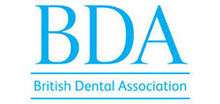British Dental Association
 | |
| Abbreviation | BDA |
|---|---|
| Formation | 1880 |
| Type | Professional body |
| Legal status | Non-profit company, Special register body and registered charity |
| Purpose | Dentistry in the United Kingdom |
| Headquarters | Wimpole Street, London, W1 |
Region served | United Kingdom |
Chief executive | Peter Ward |
Main organ | BDA Principal Executive Committee |
| Website |
www |
The British Dental Association (BDA) is the professional association and registered trade union organisation for dentists in the United Kingdom.
Its stated mission is to "promote the interests of members, advance the science, arts and ethics of dentistry and improve the nation’s oral health."
The BDA is not the regulatory body for dentists in the United Kingdom. Dentists are regulated by the General Dental Council.
Structure
The majority of the BDA’s 22,000 members are family dentists, working in general practice providing both National Health Service (NHS) and private care. BDA members also work in community and hospital settings, universities and the British armed forces.
The BDA’s headquarters is in Wimpole Street, London near Queen's College, London in the City of Westminster and it currently has offices in Stirling, Scotland, Belfast, Northern Ireland and Cardiff, Wales.
History
By the 1870s leading dentists including Sir John Tomes and Sir Edwin Saunders (one of Queen Victoria’s dentists) formed the Dental Reform Committee, to help bring unity, organisation and code of ethics to the dental profession. This Committee campaigned successfully for the first legislation to regulate dentistry, the Dentists Act, 1878 which limited the title of "dentist" and "dental surgeon" to registered practitioners.[1] Qualified practitioners and those who could show they had practised dentistry for five years prior to 1878 were the only ones eligible to register.[2]:1
The Dental Reform Committee called for a nationwide meeting to establish the BDA in 1879. Finally established in 1880 the BDA elected Sir John Tomes as its first President. Much of the BDA’s early work involved prosecuting dentists in breach of the Dentists Act.
The Dentists Act of 1921 created the Dental Board of the UK to administer the Dentists Register. Thus the BDA was freed from legislation, and rapidly emerged as the leading consultative body and voice for the dental profession.
The 1921 Act introduced a provision that only registered individuals could practise dentistry. However, unqualified practitioners were given opportunity to register if they could show they had been practising dentistry for five years prior to 1921. The last unqualified dentist ceased practise during the 1970s.[2]:2
The BDA headquarters were opened by the Queen in March 1967.
Function
The organisation represents dentists at national and local level, ensuring that the views and concerns of the profession are high on the political and public agenda.
The BDA promotes good practice and patient care, and provides members with expert advice in all aspects of practice, management and opportunities for continuing professional development.
The organisation is also a scientific society promoting higher standards (often in co-operation with other organisations) and improvements in the oral health of the nation.
Publications
The BDA produces regular dental publications, including the British Dental Journal, BDJ In Practice, BDJ Student and BDJ Team
British Dental Association Museum
Its museum in Wimpole Street holds the largest collection of dental material in Britain. It includes dental instruments, equipment, furniture, photographs, archives, fine and decorative art. The museum is maintained as a national resource for the dental profession, dental industry, researchers and members of the public and aims to promote an appreciation of dentistry today through an understanding of its past.[3] The museum is a member of the London Museums of Health & Medicine.[4]
British Dental Association Library
The British Dental Association library Is the most comprehensive dental library in Europe, and subscribes to over 200 dental journals and provides members with free Medline searches.
The Library is located at BDA Headquarters.[5]
References
- ↑ Gelbier, Stanley (2005). "125 Years of Developments in Dentistry". British Dental Journal 199 (7): 470–473. doi:10.1038/sj.bdj.4812875. PMID 16215593. Retrieved 2011-01-14.
- 1 2 "BDA Dental Museum: Was your ancestor a dentist?". British Dental Association. Retrieved 5 September 2016.
- ↑ Museum website
- ↑ "Medical Museums". medicalmuseums.org. Retrieved 26 August 2016.
- ↑ BDA library access date 14 September 2016